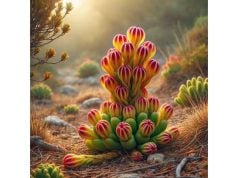Cascara Sagrada is a distinctive herb derived from the bark of the Rhamnus purshiana tree, native to the Pacific Northwest region of North America. The name “Cascara Sagrada” translates to “sacred bark” in Spanish, reflecting its historical reverence in certain traditional medical systems. As a species of buckthorn, this tree yields an interesting combination of phytochemicals within its bark, particularly known for their laxative properties. Today, Cascara Sagrada still holds a special place in herbal practice—often seen in teas, capsules, or extracts primarily aimed at supporting bowel regularity.
Although its most iconic role is as a gentle purgative, Cascara Sagrada possesses various other applications that have been noted in both folk and modern contexts. The bark, once carefully aged and processed, contains anthraquinone compounds that influence the intestines in a unique way. People looking for a natural, short-term solution to occasional constipation have frequently turned to Cascara Sagrada. However, like many herbal remedies, it’s essential to understand its properties and safe usage guidelines before jumping in.
- Recognized for helping relieve occasional constipation
- Contains anthraquinones that stimulate bowel movements
- Harvested bark must be aged to reduce harsh side effects
- Often employed in short-term cleansing or detox regimens
- Requires caution due to its potent laxative action
Table of Contents
- Cascara Sagrada Botanical Profile: Identifying the Tree and Its Key Features
- Cascara Sagrada Chronicle: A Glimpse into Historical and Cultural Background
- Cascara Sagrada Phytochemistry: Core Active Constituents and Their Roles
- Cascara Sagrada Health Support: Potential Advantages and Scope
- Cascara Sagrada Essential Properties: Foundational Traits and Functions
- Cascara Sagrada Applications and Safety: Usage Guidelines and Precautions
- Cascara Sagrada Studies: Research Insights and Significant Findings
- Cascara Sagrada FAQ: Common Questions on Uses, Benefits, and More
Cascara Sagrada Botanical Profile: Identifying the Tree and Its Key Features
Cascara Sagrada originates from Rhamnus purshiana, a deciduous tree commonly found in wooded areas along the Pacific coast, stretching from northern California up into British Columbia. Sometimes also referred to as the Cascara Buckthorn, it belongs to the Rhamnaceae family.
Physical Description
- Height and Appearance: This tree can reach heights between 20 to 40 feet, characterized by a thin trunk and a rounded canopy.
- Bark: The bark, the part used in herbal medicine, typically has a dark brown to grayish hue, with a somewhat corky texture. Upon peeling or cutting, the inner bark reveals a yellowish tinge.
- Leaves: Oval-shaped, with pronounced veins. They may appear glossy with serrated or smooth edges.
- Flowers and Fruits: Cascara produces small greenish flowers, which later develop into dark purple or black drupes—berries that host the tree’s seeds.
Habitat and Growth Conditions
- Soil: Prefers well-drained soils, though it can handle clay or loamy conditions.
- Moisture: Often found near streams or wetlands but can adapt to drier environments if roots have access to consistent moisture.
- Sun Exposure: Thrives in partial shade to full sun, especially in cooler, moist climates.
- Distribution: Beyond the Pacific Northwest, it’s cultivated or found in certain other North American locations, though it’s not as widespread as many other hardwood species.
Harvesting the Bark
The bark is the primary asset for herbal usage. However, it can’t be used fresh as it contains compounds that can induce intense cramping or digestive distress. Traditionally, the bark is collected, then aged (sometimes for a year or more) or heat-processed to allow certain chemical transformations—reducing harsh side effects while preserving beneficial laxative properties.
Similar Species and Confusions
Some confusion arises between Rhamnus purshiana and other buckthorn species like Rhamnus cathartica (Common Buckthorn), which does not share the same history of safe use. Ensuring correct botanical identification is crucial because other buckthorns may not be suitable for consumption. Reputable herb suppliers typically label “Cascara Sagrada” specifically as Rhamnus purshiana bark.
In essence, Cascara Sagrada’s place in the forest ecosystem and its distinct bark form the basis of its medicinal value. Knowing how and where it grows helps underscore why careful harvesting and processing are essential to safely harness its purported benefits.
Cascara Sagrada Chronicle: A Glimpse into Historical and Cultural Background
Cascara Sagrada has traversed a fascinating journey, from traditional tribal remedies to an herbal product sold in global health markets. Understanding its past reveals how deeply it is tied to the cultural practices of indigenous peoples and the evolving demands of modern consumers.
Indigenous Knowledge and Early Uses
- Pacific Northwest Tribes: Native groups like the Salish, Quinault, and others recognized the inner bark of Cascara Sagrada as a potent laxative and general purifier. Oral traditions detail bark collection and careful curing methods to moderate its effects.
- Name Origin: The Spanish settlers called the bark “Cáscara Sagrada,” meaning “sacred bark,” possibly referring to both its value and the respect given by indigenous communities to the plant.
Colonial to Modern Transition
As European and American colonists encountered indigenous medical knowledge, Cascara Sagrada piqued their interest for addressing constipation—a common issue among settlers coping with new diets and limited hygiene standards. By the late 19th century, it appeared in certain pharmacopeias and apothecaries as a standardized laxative ingredient.
- Pharmaceutical Inclusion: In the 1890s, recognized Western medicine began standardizing Cascara Sagrada extracts, blending them into patent medicines. Over time, it achieved a strong market share in over-the-counter (OTC) laxatives.
- Regulatory Shifts: In the latter half of the 20th century, more stringent regulations led to certain products containing anthraquinone laxatives (like Cascara Sagrada) being reevaluated for safety. This affected how it was formulated and sold, though the herb never lost its place in many health food stores.
Contemporary Standing
Cascara Sagrada is still widely available as a dietary supplement or herbal tea component. It’s especially popular among those seeking temporary relief from constipation or detox approaches. However, consumer awareness of usage guidelines and potential side effects has grown, shaping a more cautious but still robust demand.
Cultural Reflections
- Folk Medicine: Some older North American households recall stories of “spring cleanses” or “tonics” involving Cascara Sagrada.
- Traditional Rituals: Certain indigenous groups might also have used the plant ceremonially, though documented practices vary.
Overall, Cascara Sagrada’s heritage is deeply tied to both indigenous knowledge and Western acceptance as a potent herb. Its place in modern herbalism underscores the resilience of age-old remedies, albeit with new insights into usage and safety.
Cascara Sagrada Phytochemistry: Core Active Constituents and Their Roles
The bark of Cascara Sagrada brims with bioactive compounds, primarily responsible for its laxative effect. Through aging and processing, these compounds transform to a gentler form that’s more suitable for human consumption.
Anthraquinones at the Center
- Cascarosides: These anthraquinone glycosides are the primary driver of Cascara Sagrada’s laxative action. Upon reaching the intestines, microorganisms metabolize them, stimulating peristalsis—the muscular contractions that move stool through the colon.
- Aloe-Emodin and Chrysophanol: Like other anthraquinone-containing plants, Cascara bark also holds smaller amounts of compounds such as aloe-emodin and chrysophanol, each with mild laxative and potential antimicrobial properties.
Bitter Principles and Tannins
- Bitter Constituents: Provide the characteristic taste. When consumed, these may trigger digestive secretions—similar to how “bitter herbs” function—though the main effect in Cascara is still tied to anthraquinones.
- Tannins: Present in moderate levels, these polyphenols have astringent properties that might help offset some of the intensity of anthraquinone-induced intestinal movements. However, overabundance can cause GI upset if the bark isn’t aged properly.
Importance of Aging
Fresh Cascara bark can be harsh, containing reactive forms of anthraquinones that can provoke severe cramping. By aging or kiln-drying the bark for at least a year, enzymatic changes reduce the bark’s irritant potential, converting it to a milder but still potent remedy. Historically, a minimum one-year aging period was recommended to ensure safety and tolerability.
Nutritional Elements
Cascara Sagrada bark isn’t generally used as a nutritional supplement for vitamins or minerals. Its role is more functional, focusing on bowel regulation. Any trace levels of minerals or vitamins are overshadowed by the bark’s anthraquinone content.
Synergistic Factors
As with many herbal medicines, synergy likely exists among the various anthraquinones, flavonoids, and other compounds within Cascara bark. While individual constituents can be isolated, the overall effect is thought to come from their combined activity, modulated by the bark’s bitter components and tannins.
In a nutshell, Cascara Sagrada’s potency hinges on anthraquinones and related compounds that gently (or sometimes not so gently) stimulate the colon. Properly aging or processing the bark helps ensure these compounds remain effective while minimizing undue discomfort or irritation.
Cascara Sagrada Health Support: Potential Advantages and Scope
Cascara Sagrada is predominantly identified with its role as a gentle yet effective laxative. But the herb’s potential benefits may extend slightly beyond simple bowel relief. Below are some angles from which people have historically or anecdotally used Cascara Sagrada.
Occasional Constipation Relief
- Colon Stimulation: The bark’s anthraquinones increase peristalsis, promoting stool passage when normal movements slow down.
- Faster Onset: Compared to certain bulking fibers, anthraquinone-based laxatives can act faster, often bringing relief within 6 to 12 hours.
- Short-Term Use: Health professionals typically stress that anthraquinone-based remedies should be reserved for brief periods to address acute constipation rather than used daily.
Bowel Regularity and Detox
Some herbal traditions incorporate Cascara Sagrada into “cleansing” protocols, occasionally used after periods of indulgent eating or minimal activity. By aiding evacuation, individuals might feel a sense of lightness or improved energy, though scientific backing for full “detox” claims is more anecdotal.
Potential Digestive Toning
When used responsibly, the mild bitterness might stimulate digestive secretions, contributing to overall GI function. Still, the main impetus behind using Cascara is the anthraquinone-laxative pathway rather than a broad GI tonic effect, which is more typical of gentian or other bitter herbs.
Possible Synergies with Other Herbs
Cascara Sagrada sometimes appears in multi-herb formulas addressing constipation or digestive complaints. It may be combined with soothing agents like peppermint or fennel to mitigate cramping. Alternatively, certain fiber-rich or demulcent herbs (like slippery elm) could offset Cascara’s intensity while assisting in stool formation.
Weight Management Myths
Some individuals have tried or heard about Cascara Sagrada for weight loss, presumably due to its bowel-emptying nature. Experts advise caution: any immediate scale changes typically reflect water loss, not sustainable fat reduction. Relying on anthraquinone laxatives for weight management can disrupt electrolytes and normal bowel function if misused.
Overall Wellness Perspective
A properly timed and judiciously dosed Cascara Sagrada regimen can help those facing infrequent constipation find relief. Yet, it’s essential to understand that a balanced diet, regular hydration, and consistent activity remain foundational for healthy digestion. Cascara Sagrada is best viewed as a tool for occasional support rather than a long-term crutch.
Cascara Sagrada Essential Properties: Foundational Traits and Functions
A deeper look into Cascara Sagrada reveals various factors guiding how it’s harvested, processed, and applied in everyday or clinical herbal practice. These fundamental traits set the plant apart from other botanicals:
Distinct Laxative Action
- Anthraquinone Specificity: Cascara Sagrada’s most significant property is the presence of anthraquinone glycosides. These substances effectively stimulate the colon, contrasting with bulking fibers (e.g., psyllium) or osmotic laxatives (e.g., magnesium salts).
- Gentle Yet Potent: When properly aged, the bark can act relatively gently compared to some synthetic stimulants. However, it remains potent enough that overuse can lead to excessive bowel movements and potential cramping.
Harvesting and Aging Procedures
To mitigate harsh or irritant qualities:
- Harvest Season: Typically in spring or early summer, when the bark is somewhat softer but still robust in its active constituents.
- Drying Process: The bark is peeled from the trunk or branches, then allowed to cure for months or sometimes a full year.
- Controlled Storage: Minimizing moisture, heat, and contamination ensures stable anthraquinone content without fostering mold or spoilage.
Application in Herbal Products
- Powders: Ground bark can be encapsulated or used in herbal blends.
- Teas/Infusions: Steeping bark in water, though it’s typically combined with other herbs to offset bitterness.
- Tinctures: Alcohol-based extracts, providing a concentrated form, often used dropwise or by the spoonful.
- Tablets or OTC Laxatives: Some brands standardize anthraquinone content for consistent dosage.
Short Duration Recommendation
Due to the risk of dependency or electrolyte imbalance, mainstream guidelines advocate using Cascara Sagrada for no more than one to two weeks at a time. Extended usage can hamper normal bowel reflexes and cause reliance on external stimulation for bowel movements.
Synergistic Plant Characteristics
Cascara Sagrada’s synergy with other gentle GI herbs (like chamomile, ginger, or licorice) can smooth its intense edges. These supportive herbs may also reduce cramping or help soothe the digestive tract post-laxation.
Eco-Conscious Considerations
Given that Cascara trees are somewhat localized, ethical sourcing becomes a consideration. Unsustainable bark stripping could harm local ecosystems. Some manufacturers undertake responsible harvesting protocols or partner with sustainable suppliers to preserve wild stands.
Summarily, Cascara Sagrada’s defining properties reflect an herb uniquely optimized for short-term constipation intervention. From bark harvesting to product formulation, each step aims to preserve the anthraquinone content while ensuring user comfort and safety.
Cascara Sagrada Applications and Safety: Usage Guidelines and Precautions
While Cascara Sagrada can be a useful ally for intermittent constipation relief, it carries some important safety considerations. Understanding the best ways to use and the potential risks ensures that the experience is both beneficial and free from unwanted complications.
Typical Uses
- Occasional Constipation: Often taken as a capsule or tea in short spurts to stimulate bowel movements.
- Detox or Cleansing Programs: Sometimes integrated into holistic regimens aiming to “reset” the digestive tract. Nonetheless, experts caution that extended use is not advisable.
- Combined Formulas: You may see Cascara Sagrada in multi-ingredient laxative products, frequently paired with mild digestive herbs or gentle bulking agents.
Recommended Dosage
Dosage can vary based on factors like age, health status, and product formulation. Generally:
- Capsules/Tablets: Products often deliver around 300–450 mg of aged bark extract per serving. Users typically begin with a low dose (one capsule), taken once or twice daily, evaluating response before increasing.
- Tea: One teaspoon of dried bark steeped in hot water for 5–10 minutes, though taste is quite bitter, so many prefer extracts or capsules.
- Liquid Tinctures: A few milliliters (ml) might be added to water or juice. Following label instructions is crucial.
Safety Concerns
- Dependency Risk: Over-reliance can reduce the colon’s natural motility. Alternating or limiting usage avoids training the body to rely on external stimulation.
- Electrolyte Imbalances: Prolonged frequent bowel movements might lower potassium, which can affect heart rhythm and muscle function.
- Contraindications: Pregnant or breastfeeding individuals, young children, and those with certain GI conditions (Crohn’s disease, ulcerative colitis) or severe dehydration should avoid or use only under professional supervision.
- Drug Interactions: Diuretics, corticosteroids, and certain heart medications may intensify electrolyte depletion if combined with potent laxatives. Checking with a healthcare provider is wise.
Handling Side Effects
- Cramping: If you experience strong cramps, reduce the dose or switch to a gentler approach.
- Diarrhea: Overdose or individual sensitivity can lead to diarrhea. Hydrate well and discontinue use if symptoms persist.
- Red or Pink Urine: Occasionally, anthraquinones can cause harmless discoloration of urine. This effect should pass after stopping use.
Length of Usage
Standard medical advice suggests limiting Cascara Sagrada usage to no more than a week or two consecutively. If constipation persists beyond that, investigating underlying dietary or lifestyle contributors—like fiber intake, hydration, and exercise—might yield more sustainable improvement.
Additional Tips
- Adequate Hydration: Drinking enough fluids can ease stool passage and reduce cramping.
- Bowel Habit Monitoring: Keep track of frequency, stool consistency, and any discomfort. Adjust usage accordingly or consult a professional if issues arise.
- Nutrient-Rich Diet: High-fiber fruits, vegetables, and whole grains can naturally reduce the need for stimulant laxatives like Cascara Sagrada.
Ultimately, Cascara Sagrada serves as an occasional, short-term solution, helping many individuals who suffer from periodic constipation. Utilizing it responsibly—watching dosage, duration, and potential interactions—ensures a positive, beneficial experience.
Cascara Sagrada Studies: Research Insights and Significant Findings
Cascara Sagrada’s centuries-long use in traditional medicine has inspired modern research focusing primarily on its laxative action, safety, and the specific chemical mechanisms that set it apart from other bowel stimulants.
Historical Validation
- Early Pharmacognosy (19th Century): Early Western analyses found that anthraquinone glycosides in Cascara Sagrada accounted for the potent purgative effect. These discoveries shaped the herb’s integration into official pharmacopeias in the early 1900s.
Contemporary Investigations
- Anthraquinone Impact (2012, Phytomedicine): Lab-based analyses clarified how anthraquinones from aged Cascara Sagrada bark prompt increased colonic motility. The study indicated that measured amounts triggered contractions in a controlled manner, supporting occasional short-term use.
- Gut Microbiota Interplay (2017, Journal of Ethnopharmacology): Some in vitro research explored whether anthraquinones affect gut flora. Findings suggest that typical usage might not drastically harm beneficial bacteria, but robust, long-term data in humans remain limited.
Debates on Safety
- FDA Reclassification (Late 1990s): The U.S. FDA re-evaluated over-the-counter stimulant laxatives, including Cascara Sagrada. They ultimately required further safety evidence, leading to certain product reformulations or disclaimers on packaging.
- Genotoxicity Concerns: High doses or prolonged anthraquinone consumption in lab animals spurred some debate about the potential for DNA damage. Yet the evidence is mixed, and context matters—particularly regarding dosage and user health. Many experts emphasize moderation.
Broader GI Health Explorations
A portion of the research also examines whether anthraquinone-based herbs, including Cascara, might have ancillary GI benefits, such as mild antimicrobial effects or synergy with IBS symptom relief. However, these remain emergent areas lacking conclusive human trials.
Cascara Sagrada FAQ: Common Questions on Uses, Benefits, and More
How quickly does Cascara Sagrada work?
It typically prompts bowel movements within 6 to 12 hours, depending on factors like dosage, individual metabolism, and whether it’s taken with other foods or supplements. Most people notice its effects by the following morning if taken at bedtime.
Is it safe to use Cascara Sagrada for weight loss?
Cascara Sagrada isn’t recommended for weight management beyond occasional colon cleansing. Any immediate drop on the scale typically reflects water or waste loss, not fat. Overusing laxatives can disrupt electrolytes and normal GI function.
Can I take Cascara Sagrada daily for chronic constipation?
Long-term daily use is discouraged. Extended reliance on anthraquinone laxatives may lead to dependency, causing the colon to weaken or become less responsive. Consider dietary adjustments, increased hydration, and consulting a healthcare professional for persistent constipation.
Are there any dietary restrictions while using Cascara Sagrada?
No strict diet rules exist, but it’s wise to drink extra water to prevent dehydration and support comfortable bowel movements. Additionally, ensure your daily meals include sufficient fiber to reduce any harsh effects from the laxative.
How should I store dried Cascara Sagrada bark or supplements?
Store in a cool, dry area away from direct sunlight and moisture. Airtight containers or sealed packaging help preserve potency. Check expiration dates on commercial products and discard any that show mold, discoloration, or unusual odors.
Disclaimer
The details shared in this article are provided for educational purposes only and do not constitute medical advice. Always consult a qualified healthcare professional before making significant changes to your health regimen or using any herbal supplement.
Feel free to share this article on Facebook, X (formerly Twitter), or any other social media platform that resonates with you. Passing along knowledge about Cascara Sagrada can encourage safe, mindful, and informed use.











